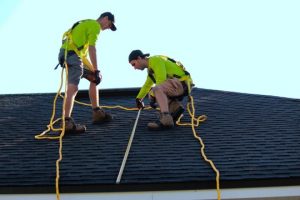Few issues in the world of homeownership are as daunting as roof damage. It is crucial to understand the extent of your roof’s condition, whether it’s a minor leak or extensive storm aftermath. Roofs are the crown of our homes, protecting us from the elements and ensuring comfort and safety. But how do you assess the extent of damage effectively? This comprehensive guide will explore essential steps in evaluating roof damage and planning the necessary repairs or replacements. From identifying early signs of trouble to making informed decisions, this post will empower you with the knowledge needed to tackle roof challenges head-on.
Spotting the Early Signs of Roof Damage
Spotting roof damage before it escalates can save you time and money. Start by strolling around your home and examining the roof from the ground. Look for missing or curling shingles, which are telltale signs of wear and tear. Remember to inspect your attic for water stains or signs of moisture, as they often indicate roof leaks. According to seasoned providers of damaged roof repairs services, if you notice daylight seeping through the roof boards, it shows structural issues. Additionally, pay attention to any moss or algae growth, as these can deteriorate roofing materials over time.
Understanding Different Types of Roof Damage
Common issues include leaks, missing shingles, sagging, and punctures. Understanding the nature of the damage is crucial for determining the appropriate course of action. Leaks are the most common problem, often caused by damaged flashing or worn-out seals around vents and chimneys. On the other hand, missing shingles can result from strong winds or aging materials. Sagging usually indicates structural issues, while punctures might be caused by falling debris or hail.
Evaluating the Cause of Roof Damage
Understanding the underlying causes of roof damage is essential to effectively addressing it. Weather events such as storms, hail, and heavy snow are common culprits. High winds can lift shingles, while hail can create dents and cracks. Poor maintenance practices can also contribute to roof deterioration. Neglecting regular inspections and cleaning gutters can result in debris buildup, trapping moisture, and accelerating wear. Additionally, improper installation of roofing materials can lead to premature failure.
Conducting a Thorough Roof Inspection
A comprehensive roof inspection is the foundation for making informed decisions. Start by choosing a calm, dry day for your assessment. Safety is paramount, so use a sturdy ladder and have a spotter if necessary. Examining the roof’s surface for visible damage, such as lifted shingles, cracks, or punctures. Next, inspect flashing around chimneys, vents, and skylights. Ensure that all seals are intact and free from wear. Check gutters and downspouts for clogs, which can contribute to water backups and roof damage. You gain valuable insights into your roof’s condition by conducting a thorough inspection.
Exploring Roofing Material Options
When it comes to roof replacement, selecting suitable materials is crucial. The market offers a wide range of options, each with its benefits and considerations. Asphalt shingles are a popular choice due to their affordability and ease of installation. They come in various styles and colors, allowing you to customize your roof’s appearance.
Metal roofing is known for its durability and energy efficiency. It can withstand harsh weather conditions and has a long lifespan. Additionally, slate and tile roofing offer a timeless, elegant look and are exceptionally durable, although they tend to be more expensive. When choosing roofing materials, consider your budget, climate, and aesthetic preferences.
Navigating the Roof Repair Process
Once your roofing project is underway, it is essential to stay in open communication with your contractor and address any questions or concerns promptly. A reputable roofer will keep you updated on the progress and timeline of the repairs. During the repair, ensure that the work aligns with the agreed-upon scope and quality standards. Look for any unexpected issues and work collaboratively with your contractor to resolve them. By staying involved, you can ensure a successful and satisfactory outcome.

Roof damage doesn’t have to be a source of stress or uncertainty. By understanding the importance of roof health, recognizing early signs of damage, and making informed decisions, you can take control of your home’s well-being. Careful planning and collaboration with professionals will ensure a successful outcome, whether opting for repairs or replacement.
Remember, a resilient roof is an investment in your home’s longevity and comfort. By staying proactive and engaged, you can protect your family, enhance curb appeal, and enjoy peace of mind with a well-maintained roof. Take the first step today and contact a trusted roofing professional for expert guidance and support.

Recent Comments